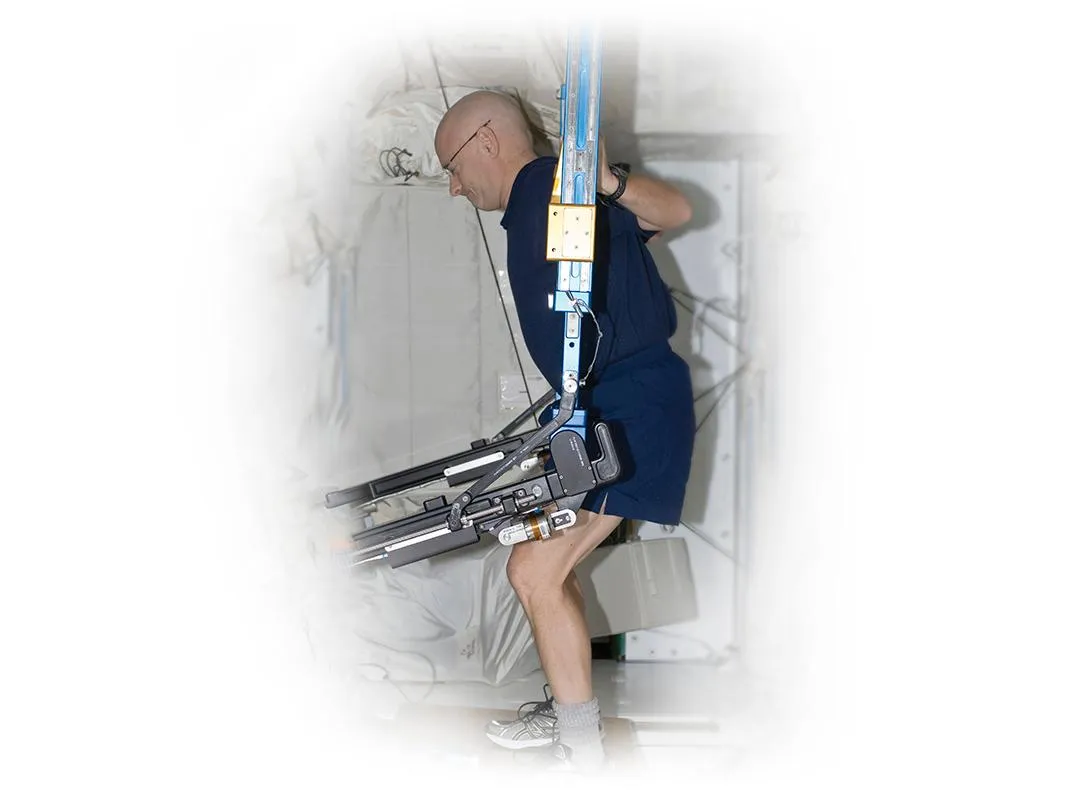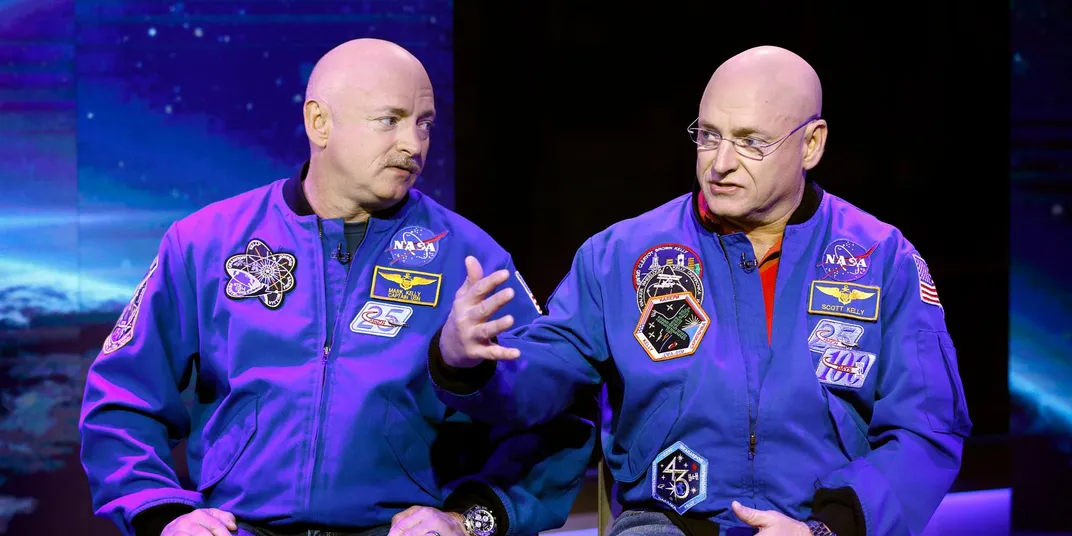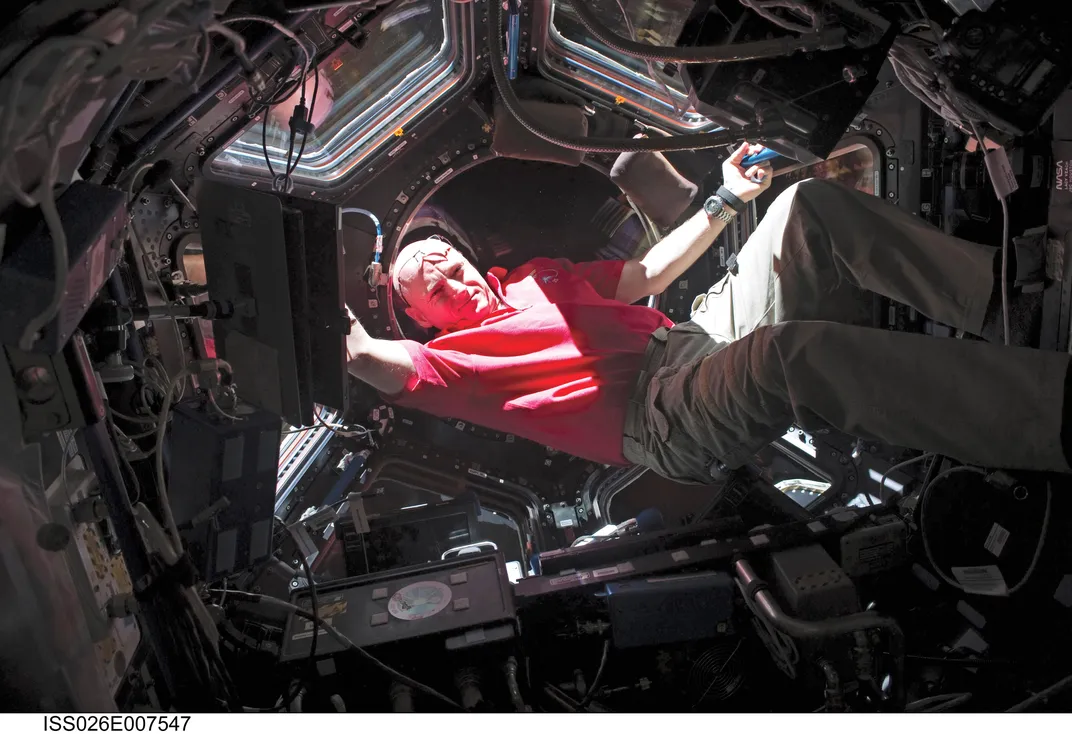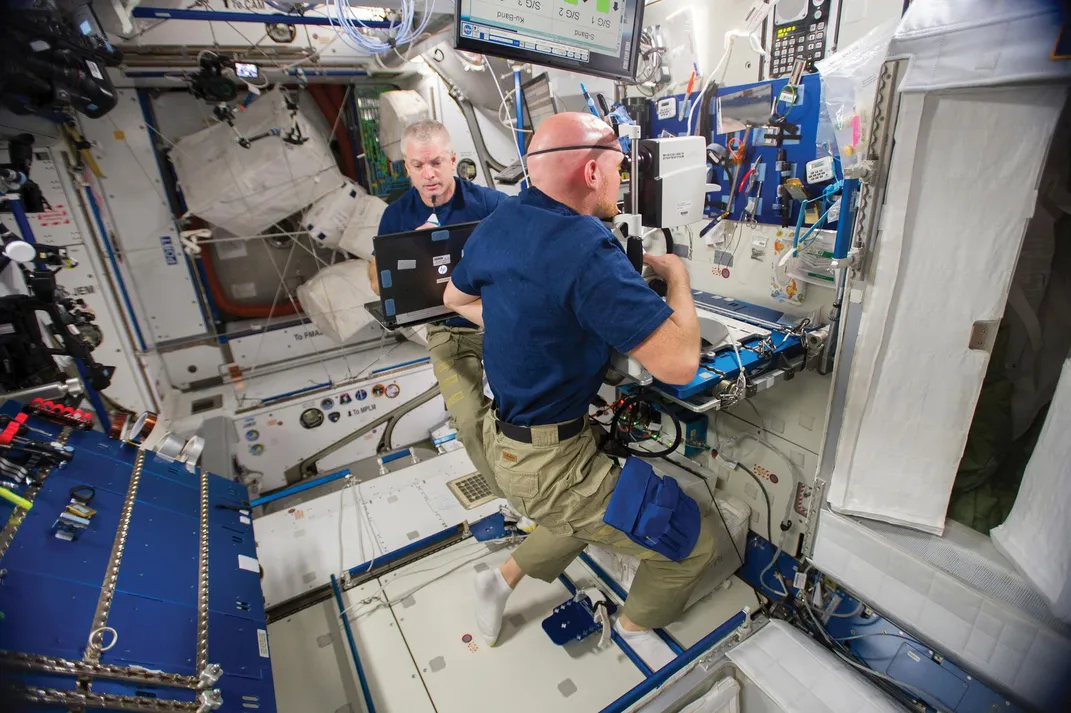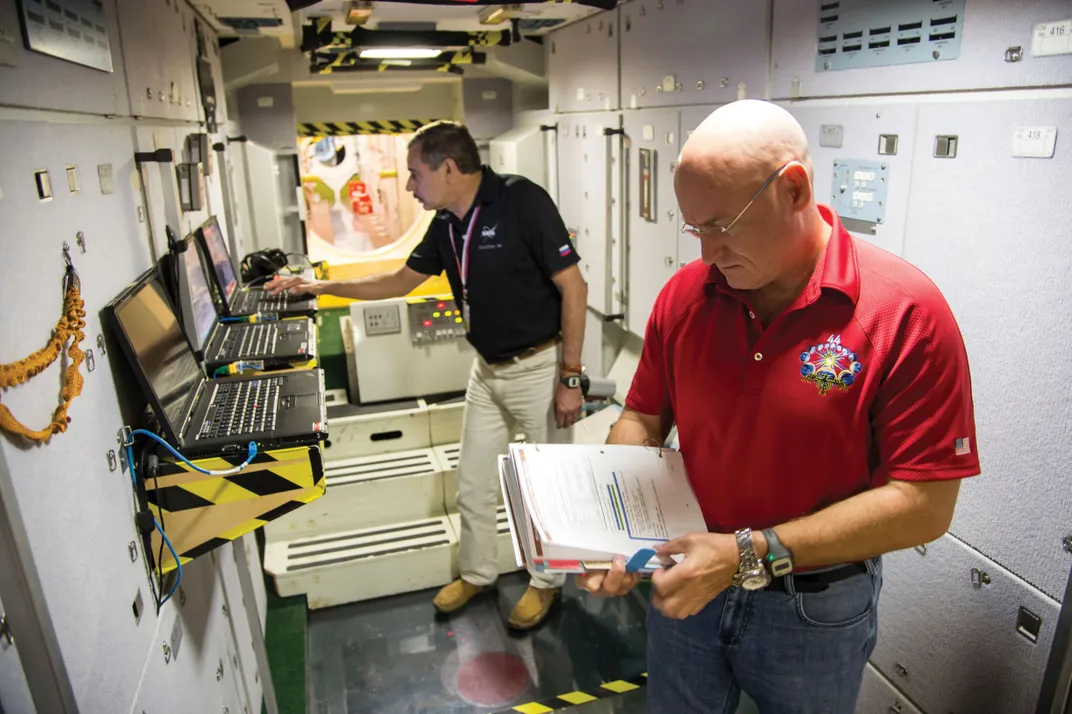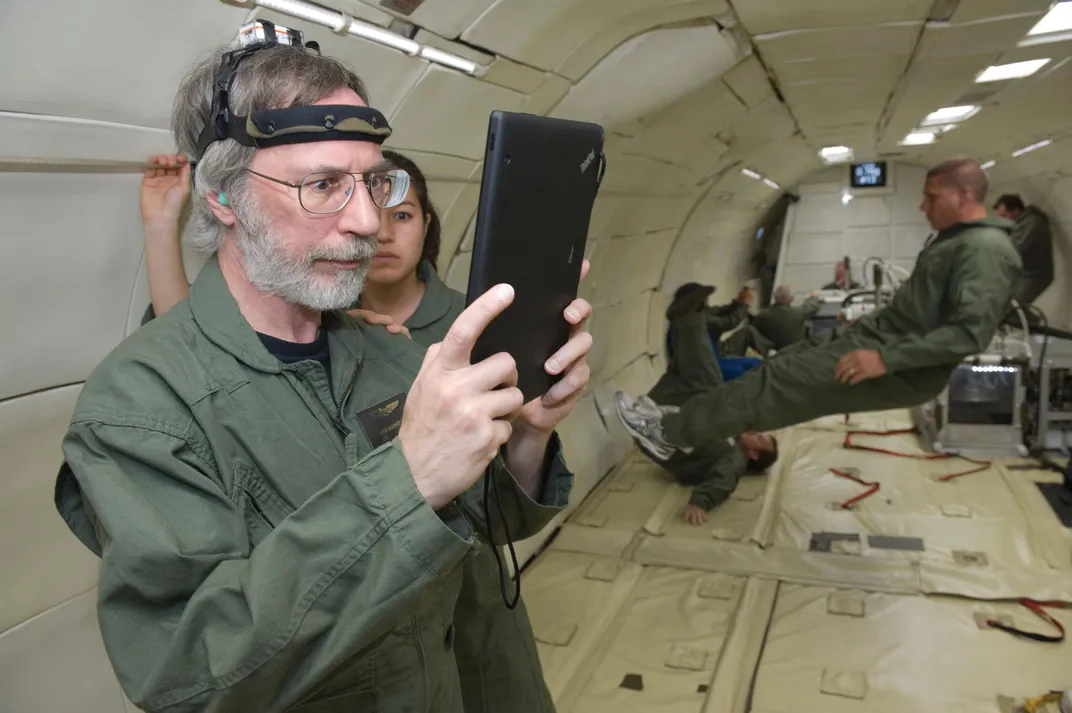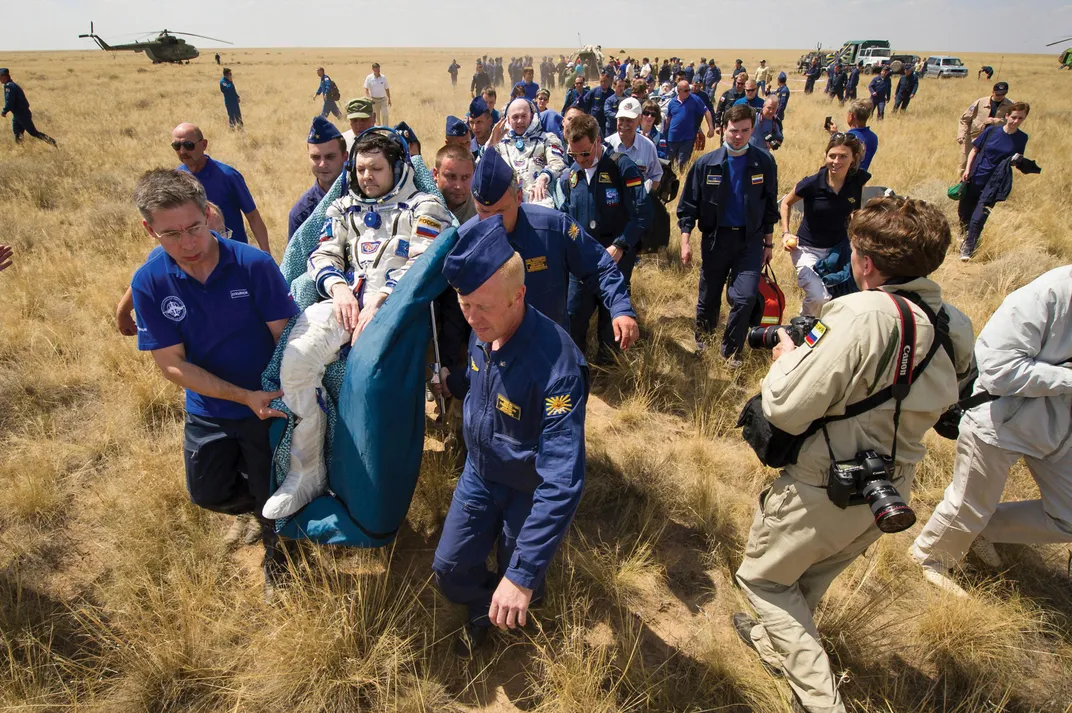Scott Kelly’s Year in Space
You think gravity wears you down? Try 12 months without it.
/https://tf-cmsv2-smithsonianmag-media.s3.amazonaws.com/filer/d4/40/d4401608-488b-4cbd-aebf-9f890f91a003/9457682923_44e4d06cae_k.jpg)
A year is a long time to spend as a human satellite circling Earth in zero gravity. But if astronauts didn’t like it, they wouldn’t sign up, right? “Don’t get the idea that there was a shortage of candidates,” says Scott Kelly, a short guy with a shaved head and a stocky build. “A lot of people wanted to do it.”
And Kelly won the prize. In late March, he and cosmonaut Mikhail Kornienko will fly to the International Space Station, orbiting 230 miles above Earth, and remain aboard for a full year. Four Russians have already spent an uninterrupted year in space, but none since Mir in 1999. Kelly will be the first American to do it. Having logged a cumulative six months in space on three prior missions, he will return to Earth with more than 500 days in orbit.
That fame may come with a price. Backaches, bone loss, lousy sleep, loss of balance, headaches, muscle atrophy, nausea, radiation exposure, rashes: There is already a well-thumbed compendium of woes that have plagued visitors to space. Says Kelly, “You feel bad for a month, and I’ve never felt completely normal.” For astronauts, physical discomfort is an occupational hazard scarcely worth mentioning when set alongside the unparalleled high of being in space. But when does that discomfort become too much?
NASA, its Russian counterpart Roscosmos, and the other station partners want to know what would happen to your body and mind if you were to travel to Mars—a round trip expected to take nearly three years. (That’s an estimated six months’ transit time in each direction, plus 18 to 20 months on Mars or orbiting it while waiting for it to realign with Earth.) A full year in space does a better job imitating the effects of so long a journey than the current six-month station sojourns. The idea is to see if people who stay in space longer get beat up worse, or if the harm occurs mainly in the early part of the mission.
Sticks and Kidney Stones
NASA has deemed some of the usual suspects to be under control, at least for six-month International Space Station missions. Two and a half hours of exercise per day appears to halt the bone loss and muscle atrophy. Drugs control nausea, and ointment helps the rashes. There are sleeping pills and pain pills.
But for a Mars mission, NASA has identified 32 “major” risks to human health and performance. These include everything from radiation poisoning, which will take a lot more than a series of year-long ISS visits to understand, to onboard fires or loss of cabin pressure, which are mostly about bad luck.
NASA’s Human Research Program, based at Houston’s Johnson Space Center, studies the other stuff: “Are there troubling trends out there?” asks Mark Shelhamer, the Research Program’s chief scientist. (There are.) “Is there a smoking gun?” he asks. (Maybe.) NASA scientists hope Kelly’s year-long ISS mission—and another five after that—will help them to find out.
First are the “pernicious” things, Shelhamer says. Some astronauts get post-flight kidney stones, and “the prevalence is troubling.” The incidence was higher after six-month ISS missions than after two-week Space Shuttle deployments. Kidney stones, as anyone who has ever had one knows, are no fun.
High concentrations of calcium oxalate in the bloodstream cause stones to form in the kidneys. Bone loss might be the culprit, but NASA’s current best guess is that the high level of carbon dioxide in the ISS air supply is to blame: It’s 10 to 20 times what we breathe on Earth.
“CO2 is acidic,” Shelhamer says. “One way your body deals with it is by buffering your bloodstream with calcium.” If a limited time in space causes kidney stones, more time might make them more likely.
Also on scientists’ to-do list are what Shelhamer calls “proving negatives.” Have the problems of bone loss, difficulty with balance, and muscular atrophy truly been solved? Longer flights offer researchers the chance to find out.
Most important, however, are the potentially dangerous imponderables—“The things we don’t feel good about,” as Shelhamer puts it—whose causes and effects remain unclear. In particular, pathogens and the human immune system interact differently in microgravity. “Some pathogens increase in virulence, and some don’t,” Shelhamer says. “Some aspects of the immune system deteriorate, some don’t.” The great fear is that at some point the “lines cross”: A pathogen becomes stronger as an immune response grows weaker. “We haven’t seen it yet, but will we see it after eight months?”
The Vision Thing
The highest-priority problem, however, is impaired vision, a condition that returning crew members have reported with increasing frequency. One U.S. astronaut discovered during reentry that he couldn’t read the checklist for landing. (Fortunately, crew members know the procedures virtually by heart.)
For years, researchers have regarded the vision problems and other microgravity effects as minor and usually reversible. On Earth, gravity pulls fluids to a person’s lower body. In space, fluids float upward with a number of unpleasant effects. Anyone who has seen astronauts on TV notices their swollen faces. Fluid migration is also a likely cause of headaches. Eyesight is so often impaired that the station stocks a supply of drugstore glasses with different magnifications.
Understanding the effects of space travel is complicated by the patient population being studied. Most astronauts are between 35 and 55 years old, clustering in their early to mid-40s, the age when a person’s eyesight usually heads south. For a long time, any ocular discomfort astronauts reported in orbit seemed to vanish once they came home.
And then it didn’t. “Right now we have circumstantial information” from astronauts reporting vision impairment, usually farsightedness, “that has lingered,” Shelhamer says. “You have it after [a stay of] six months. Maybe it’s no worse after a year, but we don’t know that.”
Vision, in part, is what got Kelly the coveted position as America’s first year-round astronaut. The candidate had to have completed a previous space station mission, had to have served as a mission commander, had to be a qualified spacewalker, and had to have been free of serious vision problems. “That cut it down to three or four people,” Kelly says. “And one of them is my backup.”
Kelly acknowledges that he, like most astronauts, has had “vision issues” on all three of his flights. In 1999 he was 35 and had “bad middle vision” for a while. Eight years later, when he commanded STS 118, he was already wearing reading glasses. And in 2010-2011, his eyesight “generally changed in a negative way” while he was aboard the space station, but corrected three months after his return. At present, Kelly, who turns 51 on February 21, wears glasses for distance.
Kornienko, 54, is also a space station veteran and a spacewalker with only four fewer days in orbit than his crewmate. Drafted out of high school into the Soviet army, he became a paratrooper, then served as a Moscow policeman while he went to engineering school. He joined the cosmonaut corps in 1998, the same year Kelly became an astronaut. He does not wear glasses, Kelly says, but may use contact lenses.
Since vision impairment came to the attention of researchers, scientists have floated several theories as to its cause: Bloodstream toxins might put pressure on the eye. Improper technique during exercise sessions might increase fluid pressure in the brain. And as always, radiation remains a suspect.
But NASA’s working hypothesis is that when weightlessness displaces fluid surrounding the brain, some of the excess migrates down the optic nerve sheath until it presses into the back of the eye. This can have grim implications: “The bogeyman is whether [a prolonged increase in cranial pressure] is going to cause other neural impacts—to fine motor coordination, headaches, memory,” Shelhamer says. If it does, “you’ve got a serious, serious problem.”
The need for research into fluid displacement is so urgent that space agency scientists will use the Kelly-Kornienko mission to begin a “fluid shifts” study, in which several station astronauts will undergo regular testing to determine the root cause of vision impairment and whatever other health implications fluid displacement might have.
Glasnost
One welcome result of the study will be a renewal of true partnership aboard the space station. Ever since it was finished, “there’s been the U.S. segment and the Russian segment,” notes John B. Charles, associate manager of NASA’s Human Research Program for International Science. The Americans do their experiments and the Russians do theirs. “The Canadians and the Japanese pretty much stick with us, and the Europeans go back and forth,” Charles says, adding that NASA would like to see that division of labor end. The agency plans to join with Roscosmos and the other partners in astronaut health experiments that involve everyone.
But the enduring mismatch between American and Russian research techniques remains a challenge: The Russians don’t measure all of the same things Americans measure, and don’t use the same terms. Both nations, over the past 50 years, have changed test protocols, hardware, and software; have added or abandoned tests; and have headed off in new research directions. As a result, significant chunks of space science have fallen into a disconnected data hodgepodge.
Furthermore, to protect astronauts’ privacy, the U.S. has a wall between flight doctors and researchers, forbidding scientists to use confidential clinical data in their studies and forbidding doctors from tapping scientists for information on their patients. But “on the Russian side, clinicians and researchers work side by side,” Charles remarks. “Sometimes they are the same person.” (Charles points out he and his colleagues are working on how to minimize that “wall” and collect more useful data, while still obeying federal laws and NASA policies protecting confidentiality.)
Finally, unlike the Americans, Russian researchers don’t use what Shelhamer calls “population-based medicine”: gathering data from lots of subjects, analyzing it, and drawing conclusions. Instead, he says, they do personalized medicine: “They look at each cosmonaut as a case study,” Charles explains. “Their research tells them everything they need to know about that cosmonaut, but it’s not the statistically based data we are accustomed to using.”
Shelhamer sees the value of both methodologies. “Who’s to say which is the more realistic approach?” he asks. “We try to find an average, but if we’re sending six astronauts to Mars, maybe it’s better to know everything about each person.”
One insight into personalized medicine may come from an experiment comparing Scott Kelly to his twin brother and fellow astronaut Mark. (Mark Kelly left the corps after his wife, former Congresswoman Gabrielle Giffords, was shot in the head by a would-be assassin in 2011.) NASA decided to undertake the study after Scott Kelly asked the brass what he should say if reporters asked him whether he and Mark would be compared. NASA turned the idea into what Human Research Program biochemist Craig Kundrot describes as a “pilot project” designed to get “some interesting data points” by “making Mark the control for Scott.” Scientists will monitor the brothers down to the molecular level, comparing their DNA, RNA, proteins, metabolites, and gut microbiomes, among other things. They’ll study macro phenomena too: fluid shifts, walking performance, jumping performance, cognition, and immune systems. Both Kellys got flu shots last fall, and both will receive frequent and comprehensive physical examinations for the duration of the mission.
In an elegant coincidence, Mark Kelly retired with 54 days in space. Scott, if all goes according to schedule, will spend 540 days, outflying Mark in space by exactly one order of magnitude.
Space Crazy
The last imponderables are the psychological stresses: long transits, physical confinement, limited contact with family, no chance for emergency evacuation. Replicating these conditions will be problematic: The mission is only a year long, the astronauts under study are exposed to a changing cast of characters, and they are in low Earth orbit, only a Soyuz ride away from home. Still, scientists see testable possibilities in a year-long mission. For the last decade, NASA astronauts have kept diaries for the “ISS journals project,” and even though “touchy-feely is not a virtue” for the astronaut corps, Shelhamer says, the diarists have a lot to say about colleagues, the workload, sleeplessness, and other irritations that the public knows little about. The journal entries have helped researchers understand the importance of communal rituals such as mealtime: When one ISS crew tapped the special supplies earmarked for incoming replacements, “the new guys were furious,” Shelhamer says.
And while astronauts understand they must get along with crewmates, the same is not true of mission control—a frequent focus of animosity. The story of the Skylab crew who balked at their workload in 1973 is legendary. Less widely known is the 2010-2011 experiment wherein Russia’s Institute for Biomedical Problems ran a 520-day Mars mission simulation for six crew members–three Russians, two Europeans, and one Chinese. University of Pennsylvania behavioral scientist David F. Dinges ran a study using a questionnaire that captured any disagreement as perceived by the astronaut. The participants reported five times as many conflicts with mission control as with other astronauts.
Two specific areas of inquiry interest Shelhamer. So far Journals Project leader Jack Stuster has not detected an across-the-board “third-quarter effect” in the psyches of astronauts. “It’s like when you’re in college,” Shelhamer says. “For the first two years it’s new and fun, and for the last year you’re focused on the finish line. Trouble comes in the third quarter, when it’s ‘I still have so far to go.’ If we extend the mission to a year,” he wonders, will disillusionment set in?
Dinges has designed a four-minute test to assess stress levels among astronauts, made up of a three-minute “psychomotor vigilance test” coupled with a one-minute “visual analog ratings” of the subject’s level of stress, degree of fatigue, and quality of sleep, among other factors.
During six-month missions the results resemble “a cubic curve,” Shelhamer says, with stress rising as the cube of elapsed time, “an extremely troubling trend. If there’s an acceleration, we’re going to have to do more research to figure out what to do about it.”
Dinges says the stress ratings generally “started out low-moderate and got higher,” but when he looked at individuals, he saw that only half the astronauts reported increased stress. “We’ve known for a long time that some people deteriorate faster than others,” Dinges says. “Vulnerable people are vulnerable.”
Even so, “there were correlates,” Dinges says. High stress levels among ISS crew members “correlated with poor sleep quality, physical exhaustion, and the workload. This looks very physiological, not mental.”
And there is a final imponderable: “Nobody understands the physiological cost of the mission,” Dinges says. “You have workload creep, inadequate sleep, confinement, and isolation. But you also have nutrition issues, low oxygen, high CO2, bone and muscle atrophy.” And then there are the “more occult issues” like fluid shift to the brain.
“It’s unlikely that there’s something metaphysical or psychological associated with this,” Dinges says. “We want to know if there is a physiological trigger: Are some people coping better, or are they blessed with physical characteristics that enable them to handle it more easily?”
Space, everyone agrees, can be nasty. It will likely be nastier for a year than for six months. Multiplying that time by a factor of 2.5 or three as we reach for Mars might make all those deprivations worse.
But for astronauts, thriving amid adversity is part of the job description.“We love a challenge,” Kelly says. “We love challenging environments.”
An airtight can bound for Mars ought to do the trick.
